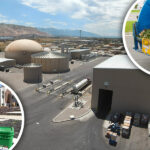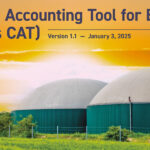BioCycle August 2015
Varennes, Quebec: Biomethane And Composting Project
Construction could begin this fall on the province of Quebec’s second anaerobic digester facility handling residential source separated organics. The $45 million (Cdn) (about $35 million US) project, first announced five years ago but delayed by financing issues, is designed to process up to about 55,000 tons annually of kitchen scraps, soiled paper, pet waste, grass clippings and soft yard trimmings from the 92,000 households in 27 rural and suburban municipalities that make up the Regional County Municipalities (RCM) of la Vallée-du-Richelieu, Marguerite-D’Youville and Rouville on the south shore of the St. Lawrence River east of Montreal.
The resulting biogas, cleaned to pipeline gas quality, will replace up to 10 percent of the natural gas that now fuels an existing ethanol plant, across the street from the planned digester near the town of Varennes. The pasteurized digestate will be provided as fertilizer to the 400 farmers who grow corn for the ethanol plant.
The 300,000-square-foot facility, still requiring final provincial environmental approvals, is to be two-thirds funded by the Canadian and Quebec governments as part of the province’s policy to support anaerobic digestion and ban compostable organics from landfills as of 2020. It is to be built and operated by an economic development group comprised of the three RCMs and Biogaz EG Québec. Biogaz EG is, in turn, a partnership of Toronto-based Greenfield Ethanol Inc., which owns the nearby ethanol plant, and Groupe Valorrr, a Quebec company that specializes in organics recycling. After a request for proposals, the group selected an Ontario company, CCI BioEnergy, to provide the core technology for the digester. CCI will use the same BTA Process ™ equipment, from Germany’s BTA International, that it employs in Toronto’s new Disco Road anaerobic digester.
The RCMs are responsible for collecting the organic materials and delivering them to the digester. Households in the regions already have curbside collection of recyclables. As the digester project goes into operation, late next year or early in 2017, they will receive kitchen buckets and wheeled, brown, 64-gallon carts. Organic materials can be contained in compostable plastic bags; regular plastic bags will be banned. Collections will be weekly between April 1 and October 31, and every two weeks the rest of the year. Households in the three regions now generate about 44,000 tons of organic materials annually. The regions will also work with businesses to provide additional feedstocks. Communications to encourage participation will use the slogan, “We put all our energy into it,” says Martin Damphousse, who heads the economic development group and is also mayor of Varennes, one of the 27 municipalities involved in the project.
Quebec’s first municipal organics digester, a 22,000 tons/year project in Rivière-de-loup, east of Quebec City, is under construction. Others are under consideration in Montreal and four other Quebec cities.
Wooster, Ohio: Ohio ATI Graduates First Class With Renewable Energy Degree
The Ohio State University Agricultural Technical Institute (Ohio ATI) created a two-year Associate of Science Degree program in Renewable Energy that offers two areas of specialization: Bioenergy emphasis focusing on generation of biogas from organic materials from the agricultural, industrial and municipal sectors, with coursework in chemistry, biology and physics as well as six courses specific to bioenergy production; and Solar and Wind emphasis focusing on production of energy production from solar panels, wind turbines, and other renewable energy technologies. “The need for clean, renewable energy is growing, and with it are growing opportunities for a workforce educated in the fields of bioenergy and solar and wind energy,” notes Ohio ATI’s website. The Associate of Science degree allows students to complete approximately 50 percent of the requirements for a Bachelor of Science degree in agriculture at The Ohio State University.
Cassie Eblin, who recently joined quasar energy group (Cleveland, Ohio) as a Regulatory Coordinator, is a member of the Ohio ATI program’s first cohort and the first to graduate with a specialization in bioenergy. Elbin had an internship at quasar while earning her degree. “Obtaining my degree has definitely enhanced my knowledge on tasks that I complete here at work,” she says. “I found my Chemistry course to be the most advantageous as I do a lot of work at quasar monitoring data generated on a monthly basis for our digesters — metals, nutrients, %TS, Fecal Coliform, pH, BOD, etc.”
Berlin, Germany: Breaking A Renewable Energy Record
An item in the online newsletter Ecowatch (www.ecowatch.com) by Emily J. Gertz of TakePart, reports that “Germany’s transition from coal- and oil-fired power to carbon-free electricity hit a new milestone on July 25 [2015] when solar, wind and other sources of renewable energy met 78 percent of the day’s energy demand.” The old record was 74 percent, made in May 2014, according to Ecowatch. “Helping set the record was an unusual weather pattern that brought heavy winds where most of the nation’s wind turbines are located. As the turbines generated more power, utilities ramped down coal- and gas-fired power plants. … But the power mix a few days earlier [was] even more encouraging. During the night of July 22, even with darkness reducing solar output to zero and no big winds in the forecast, renewables — wind, biomass, and hydropower — generated nearly 25 percent of Germany’s electricity.”
Electricity from anaerobic digesters is a significant part of the country’s biomass mix. According to the German Biogas Association, in 2014, “the 7,944 biogas plants in Germany generated about 27.6 billion kWh of electricity, thereby providing about 7.9 million households with environmentally-friendly energy. The biogas plants provide more than four percent of Germany’s electricity consumption.”
The Ecowatch news item cites research by Osha Gray Davidson, author of Clean Break (a book about Germany’s transition to carbon-free energy), who noted that Germany’s experience shows that solar and wind can keep the lights on in a highly industrialized nation. “The key indicator is percentage of electricity produced by different sources — 28 percent of Germany’s electricity comes from renewables annually, which is pretty amazing for a large industrialized country,” Davidson said, adding that Germany is a model for the U.S., “because manufacturing accounts for much more of the German economy than the American economy and they have 80 million people — much larger than a country like Denmark, which gets more of its power from renewables but has a much smaller industrial base and has a population of five and a half million people.”
North Elba, New York: Community Digester Wins State Funding
The Town of North Elba, New York received a $1.06 million grant from the Regional Economic Development Council as part of the New York Energy Research and Development Authority—Cleaner Greener Communities program to build an anaerobic digester to process about 900 tons/year of source separated organics. The town selected the prefabricated, compact EUCOlino biodigester from BIOFerm™ Energy Systems/Viessmann Group. A food scraps and soiled paper source separation pilot will start in late August at several restaurants, grocery stores and residential facilities, notes Tammy Morgan, a science teacher at Lake Placid Middle-High School, who conducted a feasibility study for a food scraps digester as part of a 10-week bioenergy-bioproducts education program fellowship. Morgan is working with Casella Waste Management, the area hauler, to conduct the pilot. More details will be provided in an upcoming BioCycle article.
Visalia, California: Dairy Digester Awarded R&D Grant By State Ag Agency
The California Department of Food and Agriculture (CDFA) announced in July that the AgPower Visalia, LLC project in Tulare County was awarded a $3 million dairy digester research and development grant. The project, developed by Camco Clean Energy, will be constructed by Regenis at the Moonlight Dairy in Visalia, the heart of California’s dairy industry, as part of the California’s aggressive push to limit greenhouse gas (GHG) emissions. When completed, the digester will generate approximately six million kWh of renewable electricity annually while allowing the dairy to safely reuse liquid on the farm from the 100,000 gallons of manure it produces each day, which in turn will save hundreds of millions of gallons of water.
Regenis will use DVO, Inc.’s Two-Stage Mixed Plug Flow™ anaerobic digester system at the Moonlight Dairy. Financial assistance for the installation of dairy digesters comes from the state’s Greenhouse Gas Reduction Fund, a cap-and-trade program for combating climate change. Through the Fund, CDFA and other state agencies are investing cap-and-trade auction proceeds in projects that reduce GHG emissions while providing a variety of additional benefits to California communities. “These projects demonstrate a commitment by California to support efforts by dairy farmers to fight climate change by reducing greenhouse gases from the agriculture sector,” said CDFA Secretary Karen Ross. “This is definitely a win-win for agriculture: cutting methane emissions and improving the environment while also generating revenue from renewable bioenergy.”














